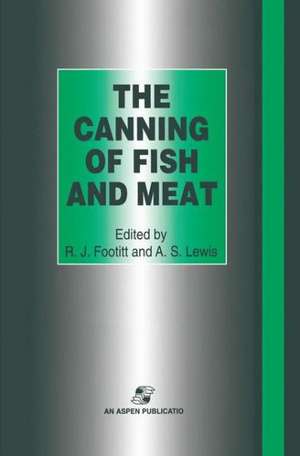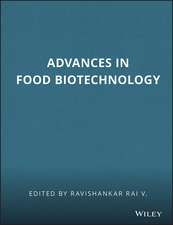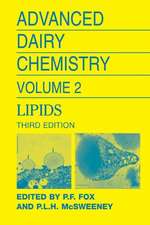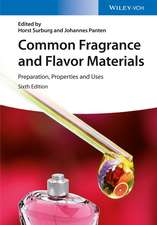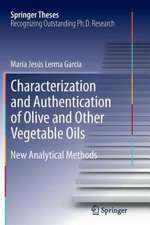The Canning of Fish and Meat
Autor R.J. Footitt, A.S. Lewisen Limba Engleză Hardback – 29 apr 1994
Preț: 952.26 lei
Preț vechi: 1161.29 lei
-18% Nou
Puncte Express: 1428
Preț estimativ în valută:
182.26€ • 189.56$ • 152.74£
182.26€ • 189.56$ • 152.74£
Carte tipărită la comandă
Livrare economică 13-27 martie
Preluare comenzi: 021 569.72.76
Specificații
ISBN-13: 9780834212916
ISBN-10: 0834212919
Pagini: 310
Ilustrații: XV, 310 p.
Dimensiuni: 155 x 235 x 19 mm
Greutate: 0.64 kg
Ediția:1999
Editura: Springer Us
Colecția Springer
Locul publicării:New York, NY, United States
ISBN-10: 0834212919
Pagini: 310
Ilustrații: XV, 310 p.
Dimensiuni: 155 x 235 x 19 mm
Greutate: 0.64 kg
Ediția:1999
Editura: Springer Us
Colecția Springer
Locul publicării:New York, NY, United States
Public țintă
ResearchDescriere
'...aimed at the technical person (and) also a good basic book for undergraduate students...' - Food Technology New Zealand' - '...especially useful for food technologists and others in the industry or training for it.' - Food Australia
Cuprins
1 Raw material sourcing.- 1.1 Introduction.- 1.2 Supply of fish.- 1.3 Finding fish.- 1.4 Catching fish.- 1.4.1 Surrounding nets.- 1.4.2 Towed nets.- 1.4.3 Static nets.- 1.4.4 Line and hook.- 1.5 By-catch.- 1.6 On-board handling of fish.- 1.6.1 Size offish.- 1.6.2 Metabolic rate.- 1.6.3 Catching practice.- 1.6.4 Handling fish.- 1.7 Quality retention.- 1.7.1 Cooling with ice.- 1.7.2 Boxing in ice.- 1.7.3 Ice-chilled sea water (CSW).- 1.7.4 Refrigerated sea water (RSW).- 1.7.5 Freezing.- 1.8 Fish farming.- 1.9 Conclusions.- References.- 2 Fish raw material.- 2.1 Introduction.- 2.2 Transportation.- 2.2.1 Spoilage factors.- 2.2.2 Protection in transportation.- 2.3 Reception and testing.- 2.4 Storage.- 2.5 Defrosting frozen fish.- 2.5.1 Air thawing.- 2.5.2 Air blast thawing.- 2.5.3 Water thawing.- 2.5.4 Vacuum thawing.- 2.5.5 Other methods of thawing.- 2.6 Fish preparation.- 2.6.1 Heading.- 2.6.2 Filleting.- 2.6.3 Skinning.- 2.6.4 Smoking.- 2.6.5 Pre-cooking.- 2.7 Storing prepared fish.- 2.8 Chemical indicators of quality.- References and Bibliography.- Appendix: Sources of machinery.- 3 Meat raw materials.- 3.1 Introduction.- 3.2 Specifications and quality assurance.- 3.3 Sampling procedures.- 3.4 Identity of meat.- 3.4.1 Species.- 3.4.2 Age and sex.- 3.4.3 Other factors.- 3.4.4 Chemical composition.- 3.5 Manufacturing quality factors.- 3.5.1 Functionality of meat proteins.- 3.5.2 Curing of meat products with nitrite.- 3.5.3 The importance of meat pH.- 3.5.4 pH changes in meat after slaughter.- 3.5.5 Chilling and freezing.- 3.5.6 Transport and delivery.- 3.6 Physical condition of meat.- 3.7 Microbiology of meat raw materials.- 3.7.1 Spoilage bacteria.- 3.7.2 Food-poisoning bacteria.- 3.8 Summary.- References.- 4 Canning factory standards.- 4.1 Introduction.- 4.2 Factory environment.- 4.2.1 Location and surroundings.- 4.2.2 Vehicles and roadways.- 4.3 Factory structure.- 4.3.1 External walls.- 4.3.2 Access ways.- 4.3.3 Pest -proofing.- 4.4 Production area.- 4.4.1 Internal walls.- 4.4.2 Floors.- 4.4.3 Ceilings.- 4.4.4 Lighting.- 4.4.5 Ventilation.- 4.5 Factory layout.- 4.5.1 Separation of processes.- 4.5.2 Separation of personnel.- 4.6 Services.- 4.6.1 General water supply.- 4.6.2 Water for cooling purposes.- 4.6.3 General steam supply.- 4.6.4 Potable steam supply.- 4.6.5 Other services.- 4.6.6 Effluent.- 4.7 Personal hygiene.- 4.7.1 Health control.- 4.7.2 Protective clothing.- 4.7.3 Sanitary accommodation.- 4.7.4 Staff amenities.- 4.8 Equipment.- 4.8.1 Hygienic design.- 4.8.2 Installation.- Further reading.- 5 Cans and lids.- 5.1 Introduction.- 5.2 Metals used in can manufacture.- 5.2.1 Steel.- 5.2.2 Tin-free steels (TFS) and blackplate.- 5.2.3 Aluminium.- 5.2.4 Mechanical properties.- 5.3 Methods of container manufacture.- 5.3.1 Three-piece can manufacture.- 5.3.2 Two-piece can manufacture.- 5.3.3 Can ends.- 5.4 Selection of a can-making route.- 5.4.1 Product(s) to be packed.- 5.4.2 Size of the market and the manufacturing unit.- 5.5 Mechanical properties of containers and ends.- 5.5.1 General.- 5.5.2 Axial strength.- 5.5.3 Panelling resistance.- 5.5.4 Peaking resistance.- 5.5.5 Measurement of mechanical properties.- 5.5.6 Secondary processes.- 5.6 Coatings.- 5.6.1 General classification.- 5.6.2 Protective internal coatings.- 5.7 Functions of can lacquers/enamels.- 5.7.1 Internal corrosion protection.- 5.7.2 Protection of the product.- 5.7.3 Facilitating manufacture.- 5.7.4 Base for decoration.- 5.7.5 External corrosion and abrasion resistance.- 5.8 Methods of lacquer application.- 5.8.1 Roller coating in sheet form.- 5.8.2 Coil coating.- 5.8.3 Spraying.- 5.8.4 Electrocoating.- 5.9 Container corrosion; theory and practice.- 5.9.1 External corrosion.- 5.9.2 Internal corrosion.- 5.9.3 Theory.- 5.10 Recycling.- 5.10.1 Technical factors.- 5.10.2 Economics.- 6 Filling operations.- 6.1 Introduction.- 6.2 Hand filling.- 6.2.1 Meat products.- 6.2.2 Fish products.- 6.3 Mechanical filling - general considerations.- 6.4 Meat filling.- 6.5 Fish filling.- 6.6 Liquid fillers.- 6.7 Fillers for fish and meat products in sauce.- 6.8 Operational safety.- 6.9 Control of the filling operation.- Acknowledgement.- Manufacturers of filling machines.- 7 Can seaming.- 7.1 Introduction.- 7.2 Can seaming.- 7.2.1 Double seamers.- 7.2.2 Irregular seamers.- 7.2.3 Round can seamers.- 7.2.4 Irregular can seaming.- 7.2.5 Round can seaming.- 7.3 Double seam acceptability.- 7.3.1 Double seam appraisal.- 7.3.2 Dimensional setting and control of double seamers.- 7.4 Target setting.- 7.5 Seamer maintenance procedures.- 7.6 Double seaming technology developments.- Glossary of terms and definitions.- 8 Heat treatment.- 8.1 Introduction.- 8.2 Aims of the retorting process and commercial sterility.- 8.3 The requirements for a retorting system.- 8.3.1 Pressure vessel.- 8.3.2 Can location.- 8.3.3 Heat transfer medium.- 8.3.4 Control system.- 8.3.5 Venting and condensate removal.- 8.3.6 Rotation.- 8.4 The classification and selection of sterilising systems.- 8.4.1 Manufacturing output.- 8.4.2 Available factory space.- 8.4.3 Requirement for rotation.- 8.4.4 Overpressure.- 8.4.5 Factory location.- 8.5 Batch retorts.- 8.5.1 Steam retorts.- 8.5.2 Steam-air retorts.- 8.5.3 Full immersion water retorts.- 8.5.4 Showered water retorts.- 8.6 Continuous sterilisers.- 8.6.1 Fundamental considerations.- 8.6.2 Hydrostatic cookers.- 8.6.3 Reel and spiral cooker/coolers.- 8.7 Instrumentation and control of sterilising systems.- 8.7.1 Temperature.- 8.7.2 Time.- 8.7.3 Pressure.- 8.7.4 Rotation speed/batch retorts.- 8.7.5 Continuous steriliser speeds.- 8.7.6 Water level.- 8.7.7 Water flow rate.- 8.7.8 Instrumentation.- 8.7.9 Temperature measurement - the master temperature indicator (MTI).- 8.7.10 Mercury-in-glass thermometers.- 8.7.11 Platinum resistance thermometers (PRTs).- 8.7.12 Temperature - recorder controller.- 8.7.13 Pressure measurement.- 8.7.14 Control systems.- 8.8 Establishment of thermal process.- 8.8.1 The scheduled process.- 8.8.2 Special considerations for canned cured meats.- 8.8.3 Thermal process verification.- 8.8.4 Temperature distribution tests.- 8.8.5 Thermal process evaluation.- 8.8.6 Calculation methods.- 8.9 Procedures and records.- 8.10 Retort operation.- 8.11 Process audit reconciliation.- Suggested further reading.- Principal European suppliers of retorts and sterilisers.- 9 Warehousing and distribution.- 9.1 Recent trends.- 9.2 The storage problem.- 9.3 Brightstacking.- 9.4 Block-stacking.- 9.5 Semi-automated warehouse systems.- 9.6 Despatch.- 9.7 Pallets versus hand stow versus slipsheets.- 9.8 Electronic data interchange.- 9.9 Stock control.- 9.10 Third-party contracts.- 9.11 Performance measurement.- 9.12 Imports.- 9.13 Distribution and shipping.- 9.13.1 Road haulage.- 9.13.2 Containers.- 10 Laboratory services.- 10.1 Laboratory facilities.- 10.1.1 Location of laboratories.- 10.1.2 Laboratory design.- 10.1.3 Technicians and procedures.- 10.1.4 Sampling plans.- 10.2 Analytical testing.- 10.3 Microbiological testing.- 10.4 Analyses recommended for cannery water and retort cooling water.- 10.5 Swab testing.- 10.6 Incubation tests.- 10.7 Sterility testing.- 10.7.1 Examination of containers.- 10.7.2 Cleaning the container.- 10.7.3 Opening the container.- 10.7.4 Inoculation.- 10.7.5 Interpretation of results.- 10.8 Types of spoilage.- 10.9 Consumer illness complaints.- 10.10 Botulism.- 10.11 Staphylococcal poisoning.- Laboratory in-house quality assurance and accreditation.- Quality assurance.- Accreditation.- ISO 9000.- Acknowledgement.- Reference.- to Quality Indicators.- Ammonia.- Total volatile bases (TVB).- K-value analysis.- Ethanol.- The Torry meter.- Total crude protein.- Estimation of moisture.- Total ash.- Crude fat: Goldfisch method.- Salt analysis.- Salt determination in solutions.- Total carbohydrates calculated as dextrose.- Qualitative determination for starch.- Histamine determination: Fluorometric method.- Quantitative determination of nitrite by the Griess-llosvay reaction.- Qualitative determination of nitrite.- Quantitative determination of hydroxyproline.- Phosphate determination.- Free fatty acids in oils.- Estimation of moisture and volatiles in oils.- Peroxide value.- Determination of Iodine number: Rosemund Kuhnenn method.- 11 Cleaning.- 11.1 Introduction to cleaning in the fish canning industry.- 11.1.1 Cleaners and sanitizers.- 11.1.2 Methods and equipment.- 11.1.3 Applying HACCP principles to cleaning.- 11.2 Introduction to cleaning in the meat industry.- 11.2.1 Slaughterhouse.- 11.2.2 Raw meat department.- 11.2.3. General factory cleaning.- 11.2.4 Personal hygiene.- Appendices 1-11.
